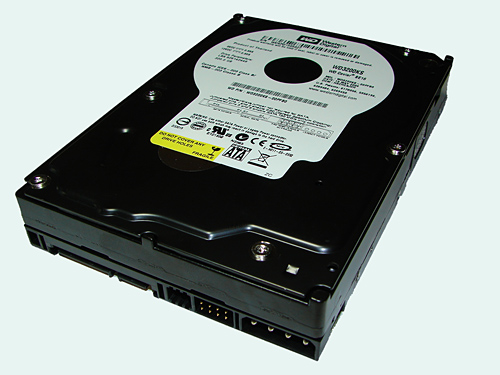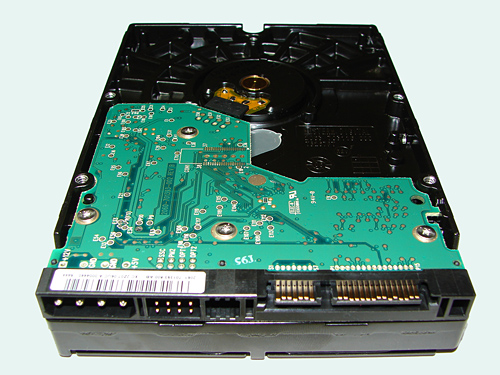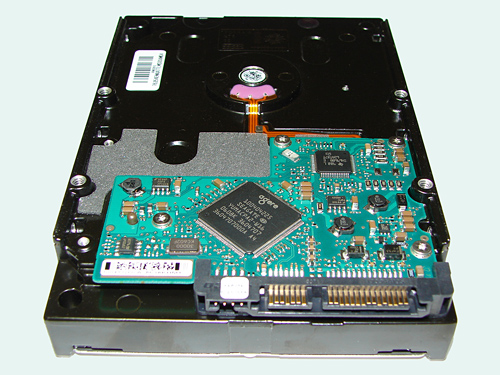Western Digital and Seagate: 320GB Grudge Match
by Gary Key on July 27, 2006 2:00 AM EST- Posted in
- Storage
Feature Set: Western Digital Caviar SE16 320GB

The external design of the Western Digital SE16 series is basically the same as other WD offerings and sports the now familiar black casing. The drive is based on the industry standard 3.5" form factor platform with pertinent part number and warranty information embossed on a white sticker on the top of the casing.

The SE16 family ships with the Serial ATA data and power connector along with a 4-pin Molex power connector designed for use with older ATX power supplies. The 4-pin power connector also allows the use of Western Digital's exclusive SecureConnect cable that significantly strengthens the SATA data connection but disables the SATA power connection. The PCB is openly visible on the bottom of the drive as in previous series with the 16 MB of cache memory and controller chips located on the opposite side of the PCB.
To the left of the SATA data and power connectors is an eight-pin jumper block. This jumper block can be utilized to implement spread spectrum clocking or force SATA 1.5Gbs operation. This drive ships with SATA 3Gbs operation enabled. While this feature was advantageous for burst transfer rates in our synthetic benchmarks, overall we did not see any measurable improvement in our real world benchmarks. Our drive was manufactured in Thailand.
Feature Set: Seagate Barracuda 7200.10 320GB

The external casing design of the Seagate Barracuda 7200.10 series is basically unchanged from the previous generation 7200.9 series. The drive is based on the industry standard 3.5" form factor platform with pertinent part number and warranty information embossed on a white sticker on the top of the casing. However boring the exterior design may be, this same casing could be holding two terabytes of capacity in short time based upon the potential of perpendicular technology.

The 7200.10 SATA family ships with the Serial ATA data and power connectors only. To the left of the data and power connectors is a four pin jumper block. This jumper block will determine whether the drive operates in SATA 1.5Gb/s or SATA 3Gb/s mode. Two pins are enabled by default, meaning the Seagate Barracuda 7200.10 ships and will operate in SATA 1.5Gb/s mode. The jumper must be removed to enable SATA 3Gb/s operation and is recommended if you have a compatible motherboard that fully supports this standard.
The PCB is openly visible on the bottom of the drive as in previous series and now contains an Agere chipset. This is different from the other 7200.10 series drives we have tested as they use the ST Micro Serial ATA controller chipset. The 16 MB of cache memory is located on the opposite side of the PCB. Our drive was manufactured in Singapore although we have another drive that was produced in the China facility.

The external design of the Western Digital SE16 series is basically the same as other WD offerings and sports the now familiar black casing. The drive is based on the industry standard 3.5" form factor platform with pertinent part number and warranty information embossed on a white sticker on the top of the casing.

The SE16 family ships with the Serial ATA data and power connector along with a 4-pin Molex power connector designed for use with older ATX power supplies. The 4-pin power connector also allows the use of Western Digital's exclusive SecureConnect cable that significantly strengthens the SATA data connection but disables the SATA power connection. The PCB is openly visible on the bottom of the drive as in previous series with the 16 MB of cache memory and controller chips located on the opposite side of the PCB.
To the left of the SATA data and power connectors is an eight-pin jumper block. This jumper block can be utilized to implement spread spectrum clocking or force SATA 1.5Gbs operation. This drive ships with SATA 3Gbs operation enabled. While this feature was advantageous for burst transfer rates in our synthetic benchmarks, overall we did not see any measurable improvement in our real world benchmarks. Our drive was manufactured in Thailand.
Feature Set: Seagate Barracuda 7200.10 320GB

The external casing design of the Seagate Barracuda 7200.10 series is basically unchanged from the previous generation 7200.9 series. The drive is based on the industry standard 3.5" form factor platform with pertinent part number and warranty information embossed on a white sticker on the top of the casing. However boring the exterior design may be, this same casing could be holding two terabytes of capacity in short time based upon the potential of perpendicular technology.

The 7200.10 SATA family ships with the Serial ATA data and power connectors only. To the left of the data and power connectors is a four pin jumper block. This jumper block will determine whether the drive operates in SATA 1.5Gb/s or SATA 3Gb/s mode. Two pins are enabled by default, meaning the Seagate Barracuda 7200.10 ships and will operate in SATA 1.5Gb/s mode. The jumper must be removed to enable SATA 3Gb/s operation and is recommended if you have a compatible motherboard that fully supports this standard.
The PCB is openly visible on the bottom of the drive as in previous series and now contains an Agere chipset. This is different from the other 7200.10 series drives we have tested as they use the ST Micro Serial ATA controller chipset. The 16 MB of cache memory is located on the opposite side of the PCB. Our drive was manufactured in Singapore although we have another drive that was produced in the China facility.










20 Comments
View All Comments
Wesley Fink - Thursday, July 27, 2006 - link
Actually, as strange as it sounds, Gary is correct on the WD warranty. You can check it out for yourself at http://support.wdc.com/warranty/policy.asp">http://support.wdc.com/warranty/policy.asp. OEM (bulk) drives carry a 3-year warranty and retail drives carry one year with an option to add 2 more years (to 3 total) for $14.95. Enterprise drives like Raptor carry a 5-year warranty.Wesley Fink - Thursday, July 27, 2006 - link
Corrected.archcommus - Thursday, July 27, 2006 - link
I'm guessing it should be "...where heavy read requests were prevalent." Just a heads up.
Wesley Fink - Thursday, July 27, 2006 - link
Typo fixed.Zaitsev - Thursday, July 27, 2006 - link
Nice article, Gary. I enjoyed the background info on the two companies.A quick question: Is it possible the str of the Seagate is higher because of a higher areal density due to having only two platters vs. the WD's three? Or have I overlooked something and need to go to sleep :)
AkumaX - Thursday, July 27, 2006 - link
Nice article. We win either way!!! I'd rather go with Seagate though because I've had to RMA too many WD's in the past few years.Does anyone know of an app that measures HDD throughput (as in MB/s, read/write or both) in realtime?
Calin - Thursday, July 27, 2006 - link
I found strange how big a difference is in some bencmarks between one drive and the other (losing or winning). Anyway, each drive looks good value for moneyGooger - Thursday, July 27, 2006 - link
HDTACHPerformanceTest 6.0 (PassMark Software)
PC Pitstop @ PC Pitstop.com (requires internet explorer)
Googer - Thursday, July 27, 2006 - link
http://www.simplisoftware.com/Public/index.php?req...">http://www.simplisoftware.com/Public/index.php?req...AkumaX - Saturday, July 29, 2006 - link
Sorry, HDTach is a benchmark. I'm looking for something that actually tells me how my hard drive is doing at the moment